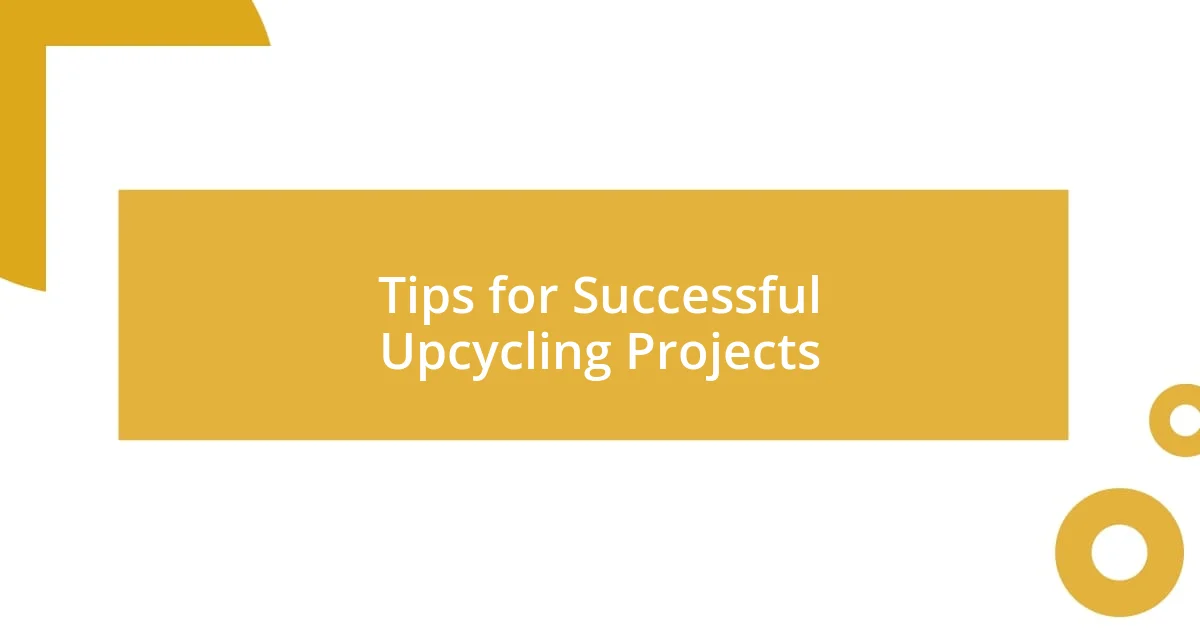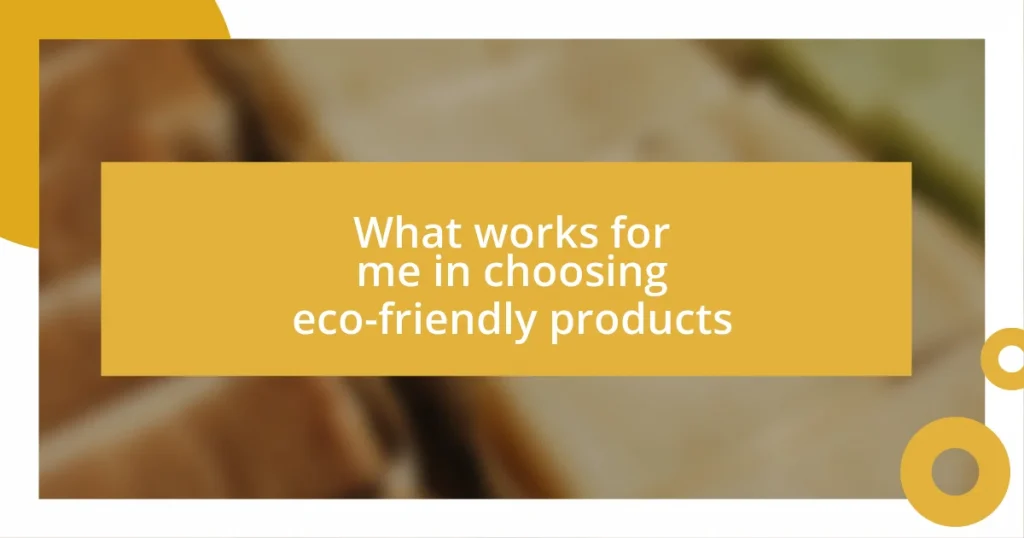Key takeaways:
- Upcycling furniture enhances creativity and sustainability, transforming neglected pieces into unique decor while reducing landfill waste.
- Key benefits of upcycling include cost-effectiveness, positive environmental impact, and adding personal stories to home decor.
- Successful upcycling involves assessing the furniture, envisioning the final look, and being flexible during the creative process, supported by community engagement.

Understanding Upcycling Furniture
Upcycling furniture is more than just a trend; it’s a journey into creativity and sustainability. I remember my first attempt at upcycling an old dresser. I felt a burst of excitement as I stripped away the old paint and dyed it a vibrant teal—transforming it from a neglected piece to a centerpiece in my living room. Have you ever experienced that thrill when something seemingly worthless finds new life?
The beauty of upcycling lies in its potential; it allows us to breathe new life into furniture that might otherwise end up in a landfill. It’s about storytelling, too. Each piece carries its history, and when you add your own touch, it creates a unique narrative that reflects both the past and your personal style. Isn’t it amazing how a little paint can evoke so many memories and emotions?
Understanding upcycling also means recognizing the environmental benefits. By repurposing old furniture, we’re reducing waste and minimizing our carbon footprint. I find it incredibly satisfying to think that my creative choices contribute to a more sustainable future. So, when you look at that old chair or table in your garage, what kind of story could it tell if you decided to give it a second life?

Benefits of Upcycling Old Furniture
Upcycling old furniture not only saves money but also sparks creativity. For me, there’s nothing quite like the satisfaction of turning a worn-out piece into a stunning conversation starter. When I transformed an old wooden bench into a cozy outdoor seat, I couldn’t help but feel proud of the transformation. It’s amazing how a little effort can create something that feels uniquely mine, isn’t it?
One key benefit of upcycling is its positive environmental impact. By choosing to upcycle instead of disposing of furniture, we’re actively reducing landfill waste. I always think about how much resource and energy goes into producing new items. When I see a dated chair that once just collected dust, I see the potential for it to become an eco-friendly masterpiece in my home. Doesn’t it make you feel good to know you’re making a sustainable choice?
Additionally, upcycled furniture often carries a personal story, which adds character to our living spaces. I remember when I salvaged some reclaimed wood from an old fence to create a coffee table. Each knot and imperfection told a story of its own, making my living room feel more inviting. The blend of history and my personal touch makes it far more than just furniture—it’s a piece of art. Have you ever thought about the stories your spaces could tell with upcycled pieces?
| Benefits of Upcycling | Description |
|---|---|
| Cost-Effectiveness | Saves money by revamping old items instead of buying new. |
| Environmental Impact | Reduces waste and helps lower carbon footprints. |
| Personal Touch | Adds character and uniqueness to your home decor. |

Best Materials for Upcycling Projects
When it comes to choosing materials for upcycling projects, I’ve found that some stand out for their versatility and enduring quality. Take wood, for instance; it’s robust and can be easily transformed with paint or varnish. I once discovered a pile of old wooden crates at a flea market. After a thorough sanding and a splash of white paint, they became charming storage solutions in my living room.
Here are some of the best materials I recommend for upcycling:
- Wood: Durable and can be painted, stained, or left natural for a rustic look.
- Fabric: Perfect for reupholstering chairs or creating cushions; choose durable upholstery fabric or even vintage linens for character.
- Metal: Items like old furniture legs or metal trays can be polished or painted for a fresh look.
- Glass: Jars and bottles can be reimagined as vases or storage containers, adding a touch of elegance.
- Paper: Use decorative paper or decoupage to spruce up surfaces and add unique designs.
I also love using hardware like knobs and hooks, which can completely change the look of a piece without much effort. I once replaced the drawers’ handles on an old nightstand with mismatched antique pulls, giving it an eclectic vibe that became a talking point for guests. It’s truly fascinating how the right materials can elevate an upcycling project from mundane to extraordinary.

Creative Upcycling Ideas for Furniture
Transforming a typical wooden ladder into a unique bookshelf is one of my go-to upcycling ideas. I recall my excitement when I stumbled upon an old ladder at a garage sale. After giving it a good clean and a fresh coat of paint, I arranged it against my living room wall, and it became an eye-catching display for my favorite books and plants. Isn’t it wonderful how something meant for climbing can turn into a piece that makes your space feel more alive?
Another creative approach I love is repurposing old dressers. One time, I took a vintage dresser with a worn-out finish and converted it into a charming TV stand. By removing the drawers and painting the exterior a bold color, I created open shelving that not only showcased my entertainment system but also added a pop of personality to the room. Have you ever thought about how a basic piece can adapt to your current needs while still looking stylish?
For those looking to add a personal touch, using old windows as picture frames can be a striking idea. I vividly remember rescuing some antique windows from my neighbor’s yard, wanting to preserve a piece of history. I created a gallery wall with these frames, each one displaying cherished family photos. The combination of nostalgia and creativity made my space feel uniquely mine, inviting guests to share stories as they admired the display. How do your furnishings reflect your journey?

Step by Step Upcycling Process
When I decide to upcycle a piece of furniture, the first thing I do is thoroughly assess its condition. This step is crucial because it helps me determine what repairs or modifications are necessary. I remember tackling an old, wobbly chair that seemed destined for the trash. After tightening the screws and reinforcing the joints, it became a sturdy piece that could support me as I sipped my morning coffee. Have you ever rescued a piece that seemed beyond salvation?
The next step I take is envisioning the final look. I often grab some paint swatches or fabric samples that catch my eye. Visualizing what the piece will become sparks my creativity. For instance, while upcycling an outdated side table, I took inspiration from a vibrant sunset I saw during my travels. I chose hues of orange and pink, and after a couple of coats, that side table transformed into a vibrant focal point in my living room. How do colors and textures inspire you to take on a project?
Finally, I dive into the fun of decorating and accessorizing. Once the furniture piece is upcycled, I love accessorizing it with unique finds from thrift stores, like a vintage lamp or quirky books. This creative finale brings me joy and allows my personality to shine through. I still smile recalling how I completed my upcycled chair with a colorful crochet blanket draped over one arm. It became not just a functional piece but also a cozy spot that invited friends and family to gather. What special touches do you think you’d add to make a piece your own?

Tips for Successful Upcycling Projects
To kick off a successful upcycling project, I always remind myself to set a clear intention for the piece. It’s so easy to get sidetracked by countless ideas! For example, when I decided to refresh a bland coffee table, I focused on transforming it into an inviting centerpiece for my living room, rather than trying to turn it into something entirely different. Have you ever found that having a specific purpose in mind helps guide your creativity?
Another tip I swear by is allowing for flexibility during the process. Sometimes, I think I know exactly what I want, but as I work, a new idea often emerges. When I was upcycling an old chair, I initially intended to keep the original upholstery, but once I started stripping it down, I saw the beautiful wood underneath. Embracing this unexpected change not only enhanced the chair’s beauty but also added a personal touch to my project that I hadn’t anticipated. Isn’t it fascinating how creativity can lead us down unexpected paths?
Lastly, never underestimate the power of community. Engaging with others who share your passion can provide invaluable insights and support. I remember joining a local upcycling group and was amazed by the ideas that flourished during brainstorming sessions. The camaraderie and encouragement I received motivated me to tackle bigger projects, like creating a stunning outdoor bench from an old door. How has collaboration inspired you in your upcycling adventures?















